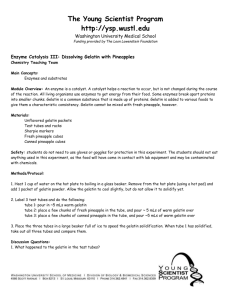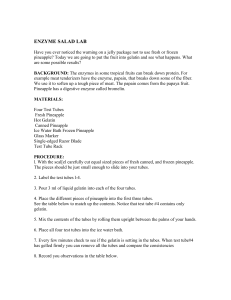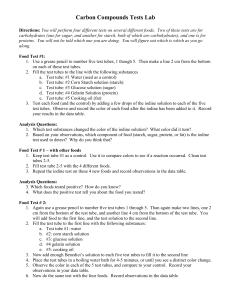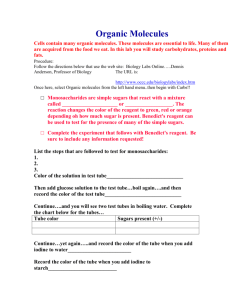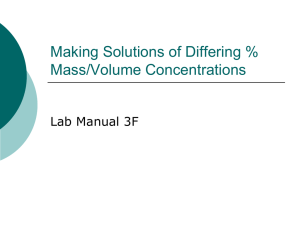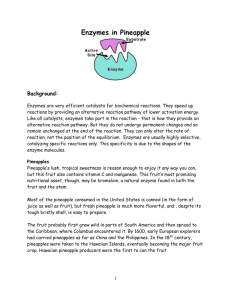THE PROPERTIES OF PROTEINS
advertisement
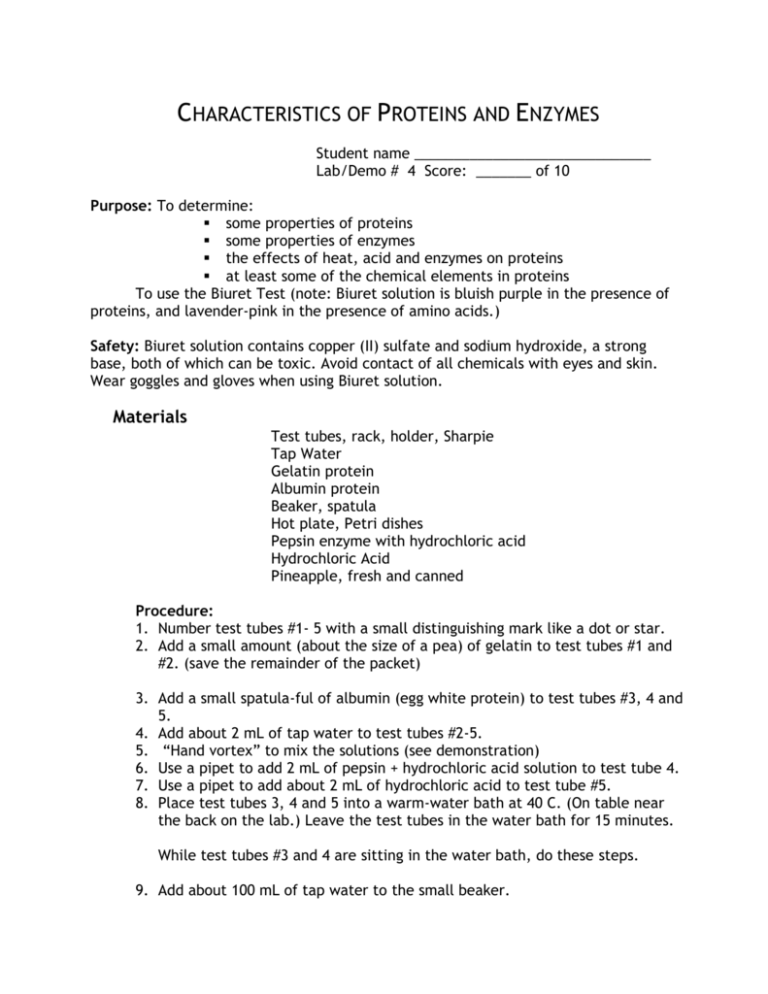
CHARACTERISTICS OF PROTEINS AND ENZYMES Student name ______________________________ Lab/Demo # 4 Score: _______ of 10 Purpose: To determine: some properties of proteins some properties of enzymes the effects of heat, acid and enzymes on proteins at least some of the chemical elements in proteins To use the Biuret Test (note: Biuret solution is bluish purple in the presence of proteins, and lavender-pink in the presence of amino acids.) Safety: Biuret solution contains copper (II) sulfate and sodium hydroxide, a strong base, both of which can be toxic. Avoid contact of all chemicals with eyes and skin. Wear goggles and gloves when using Biuret solution. Materials Test tubes, rack, holder, Sharpie Tap Water Gelatin protein Albumin protein Beaker, spatula Hot plate, Petri dishes Pepsin enzyme with hydrochloric acid Hydrochloric Acid Pineapple, fresh and canned Procedure: 1. Number test tubes #1- 5 with a small distinguishing mark like a dot or star. 2. Add a small amount (about the size of a pea) of gelatin to test tubes #1 and #2. (save the remainder of the packet) 3. Add a small spatula-ful of albumin (egg white protein) to test tubes #3, 4 and 5. 4. Add about 2 mL of tap water to test tubes #2-5. 5. “Hand vortex” to mix the solutions (see demonstration) 6. Use a pipet to add 2 mL of pepsin + hydrochloric acid solution to test tube 4. 7. Use a pipet to add about 2 mL of hydrochloric acid to test tube #5. 8. Place test tubes 3, 4 and 5 into a warm-water bath at 40 C. (On table near the back on the lab.) Leave the test tubes in the water bath for 15 minutes. While test tubes #3 and 4 are sitting in the water bath, do these steps. 9. Add about 100 mL of tap water to the small beaker. 10. Pour the rest of the packet of gelatin protein into the water, and stir until the gelatin dissolves partly, about 2 minutes. 11. Heat the gelatin/water until the gelatin has completely dissolved. 12. Pour the heated gelatin into the two Petri dishes and allow to cool overnight. 13. Use a pipet to add about 2 mL of hydrochloric acid to test tube #5. Record your observations in the table. 14. Holding test tube #1 carefully with the test tube holder, heat the gelatin gently over a low Bunsen burner flame. Record your observations (hint: look for a color change and one more observation – ask me if you are not sure). Don’t heat the gelatin too strongly or the test tube will be impossible to clean. 15. Remove test tubes 3 and 4 from the water bath. 16. Add about 2 mL of Biuret solution to test tubes 2, 3 and 4. Record your observations. 17. Clean up all test tubes and leave the clean test tubes upside down in the test tube rack at your lab table. 18. Write an explanation that answers the questions below. Test tube 1 Contents Gelatin protein, heated 2 Gelatin + water + Biuret 3 Albumin + water 4 Albumin + water + pepsin 5 Albumin + water + acid Observations Questions to guide your explanation (write or type on a separate sheet). Test Tube #1 1. What is the distinctive smell as you heat the protein? 2. When you heated the gelatin and it turned color, what chemical element does that color suggest? 3. When you heated the gelatin and condensation appeared, what chemical compound does that suggest, and what chemical elements are in that compound? Test Tube #2 When you combined the Biuret solution with the gelatin, what color did you obtain? What does that mean about gelatin? Test Tube #3 When you combined the Biuret solution with the albumin, what color did you obtain? What does that mean about albumin? Test Tube #4 When you combined the Biuret solution with the albumin after it was combined with the pepsin, what color did you obtain? What does that mean about albumin and pepsin? Is there evidence that the pepsin digested the albumin? What is pepsin? Test Tube #5 When you combined the acid solution with the albumin, what was the change you observed? What other process (chemical or physical) makes egg white look the same way? Part 2: Gelatin, the following Day. Place a chunk of pineapple in one Petri dish and one of cooked pineapple in the other. Record your observations after one hour: Record your observations after 24 hours. On the last day, clean up your Petri dishes and throw the pineapple bits in the compost. Questions: What are all proteins composed of? What is gelatin? (what is its origin?). What is albumin? (what is the origin of the sample we used? Where does it occur in human beings?) Raw pineapples and certain other fruits (papaya and kiwi) cannot be combined with Jell-o dessert, which contains gelatin. Describe what would happen to it. What might explain what you observed with the gelatin? Think about what proteins are and what amino acids are (use your glossary terms to help you). Does the canned pineapple have the same effect? Why, or why not? Because of that, what is the effect of heat on the enzyme Bromelain, which occurs naturally in Pineapple? What does this suggest is the effect of heat on proteins?

